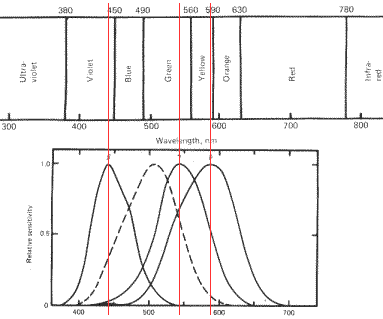People see colours initially because of the cone-shaped cells in the eye. These hold pigments that are receptive to different wavelengths of light. Roughly speaking, they are able to receive primarily “red” (actually, nearer to yellow-orange) or green, or blue wavelengths (again, nearer to indigo) with a certain degree of spread to either side, comprising trichromatic vision. (These are often referred to as Long, Medium and Short wave receptors, but Red, Green and Blue are still used at times, and may be easier to understand.) Figure 1 illustrates this relationship.

Figure 1 – Relation of wavelengths to cone receptivity.
The rods are receptive to wavelengths between blue and green, but only as luminosity. There are about twice as many red cones (60%) as green (30%), and about 10% of cones are optimised for blue. The blue cones are particularly scarce around the fovea.
The cones don’t directly report on the colours received, but rather interact with other circuits in the brain, so that certain signals are ‘added’ together, and others are ‘subtracted’ from each other. The final subjective perception is also affected by psychological and linguistic issues. This work only deals with the wavelengths received by the cones, as only those can be influenced by the designer.
In typical abnormal colour vision, there are varying degrees of difficulty with one of these receptors. Most colour blindness involves red or green, and is hereditary via the X chromosome, and hence affects men more frequently than women. It is commonly accepted that 8% of men are colour blind to some extent. This is made up of roughly 5% green-insensitive trichromats, 1% red-insensitive trichromats, <1% red-blind and <1% green-blind dichromats.

Figure 2 – Diagram of the relative incidence of types of male colour vision deficiency.
In an anomalous trichromat, the colour reception of the green cones is shifted towards the red end of the spectrum, to a greater or lesser degree; or else the reception of the red cones is shifted towards the green part of the spectrum. Hence the range of deficiency varies greatly, according to the degree of shift in wavelength reception. In a dichromat, either the red or the green pigment is totally missing.
In a red-blind dichromat (protanope), there is an additional complication, not compensated for in the palettes on this site. When the red cones are not there, the overall level of the light received by the eye is reduced, as so many cones are normally tuned to red, and receive the upper wavelengths (see Figure 1). This means that colours with a lot of red will seem darker than shown in the palettes. So red text on a black background causes particular difficulty.
This phenomenon is unusual among women, with 0.4% of women having any sort of colour vision deficiency at all, 0.38% being deuteranomalous (that is, deficient in receiving green). Only about .005% of the population (male and female) are totally colour blind, and 0.003% have tritanopia, or blue-blindness.
However, oddly enough, this doesn’t simply affect how one perceives red or green, but also colours which vary from each other by the amount of red or green they contain. In addition, because Protanopes are less sensitive to light at the red end of the spectrum (because such a large proportion of the cones are tuned to the longer wavelengths), colours in this area appear darker to them. Deuteranopes do not see this luminosity difference, as the other cones and rods can compensate.